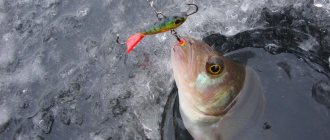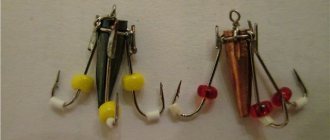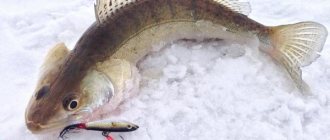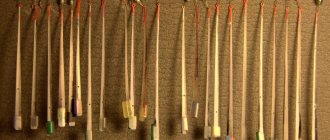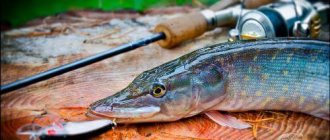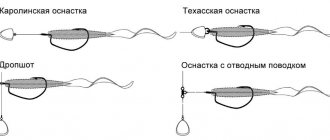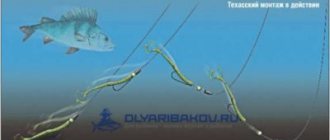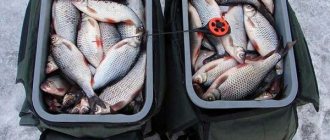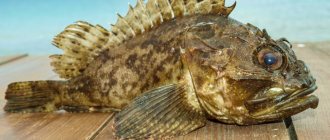Proper equipment of a winter fishing rod for roach and the correct technique for catching this fish are the basis for successful fishing. One of the most common fishing methods is passive, which involves throwing equipment into the hole, after which visual control of the bite is carried out using a float or nod. This article describes exactly this method of fishing. Active fishing with baited jigs, as well as baitless baits, is described in the relevant articles on our website. Equipping a fishing rod for roach in winter can be implemented in various equipment options, depending on the fishing conditions and the preferences of the angler.
How do roaches winter?
The roach does not sleep in winter; it feeds all winter. Depending on the weather, it may be more or less active. At the beginning of winter, it feeds in shallow areas and its summer favorite places, gradually sliding into deeper areas of the reservoir. Then the fish gradually becomes more active, feeds more often and more, and again comes closer to the shore. Read more about the winter habits of roaches here:
Many anglers successfully catch roach in winter using a float and nod throughout this cold season. Others sometimes cannot catch anything other than a couple of small fish. To successfully hunt roach in winter, you need to go through several “stages” and put together some “variables” in the roach bite equation:
- The choice of fishing tactics depends on the time of year and the characteristics of the reservoir.
- Search directly on the reservoir.
- Correct ice feeding system and bait composition.
- Correct equipment and bait.
Catching roach with a winter fishing rod - tactics and searching for fish
I hope you have read the general article on winter roach linked at the beginning of this post. From it you will understand at what time and in what places you need to look for this fish in winter. Let's assume that we have decided on the reservoir, time and all other factors, and decided to fish passively using a float (or nod).
It is important to understand that in order to find roach sites on a body of water, especially a large one, you should actively search for it. All tactics for catching this fish in winter are based on this. It's good if this place is known in advance. You can join the fishing town that grew up on the ice - it’s not just that they all sit in one place. If you don’t like noisy companies, then move away from the crowd of fishermen at least 500 meters to get to another feeding area, so that the presence of tens and hundreds of kilograms of bait under fishing tents does not spoil your tactics.
You can successfully use under-ice fishing cameras for searching. Provided there is good visibility under water, exploration using this device can be carried out much faster than with a fishing rod.
Places to look
Technique for catching roach in winter using a float rod
To successfully catch roach from ice, the angler will need to choose the right bait and bait, as well as choose the optimal place. Knowing the right moment to hook also affects the fishing result.
How to choose a place for fishing and prepare it
In roach fishing, a lot depends on the choice of fishing location. In winter, this representative of the ichthyofauna can be found:
- on flat plateaus with a depth of 3–4 m, located next to the riverbed;
- in coastal river pools;
- on large reaches;
- in local pits.
You should not look for this species in areas with a depth of more than 5 m. Along the first and last ice, large individuals often reach shallow coastal waters.
Arriving at a reservoir, the angler should immediately drill 3-4 holes at depths of 2.5 to 4 m. Each hole must be thoroughly cleaned of sludge. Ice must be thrown in the direction opposite to the direction of the wind. Otherwise, the fishing line will constantly cling to frozen ice chips.
The fishing box is installed in such a way that it covers the hole from the wind. Thanks to this arrangement, the ice crust will form much more slowly. To make the fishing process more comfortable, you can set up a tent on the ice.
What to catch and what to feed
When fishing for roach in winter, animal types of baits are used. These include:
- bloodworm;
- burdock moth larva;
- maggot;
- pieces of dung worm.
If there are no bites, you can experiment with combinations and volume of baits.
Read the article: “What to use to catch roach in winter”
To attract fish, bait mixtures are used. They are usually based on plant components. Bloodworms or small maggots are used as animal additives.
At the initial stage, about 200 g of the moistened mixture is lowered into the hole. This procedure is performed using a special feeder. During the fishing process, additional feeding is carried out at intervals of once an hour. You need to feed in small portions of 50–70 g.
How to spot a bite and hook it correctly
As a rule, in winter the roach bite on a float rod is more careful than in the warm season, so determining the right moment to hook is often quite difficult. Much depends on the activity of the fish at the time of fishing.
When the fish’s feeding activity is high, the bite looks like a quick rise of a float to the surface. It is at this moment that the hook should be made.
When the fish is passive, a bite can be a slight movement of the alarm or a barely noticeable movement of the float to the side. In this case, you should hook at the slightest hint of a roach touching the bait.
The hook is made with the hand. This allows you to avoid breaking the equipment when biting a trophy specimen.
Finding a cool place
A winter float rod for roach can be effectively used in combination with gear for active fishing with a jig.
- After determining the initial location, you need to drill 6-10 holes at a distance of 10-15 meters from each other. Closer is not recommended.
- Spot feeding is one of the “golden” rules for roach.
- The second rule is that you cannot feed too much and only once. You need to feed little by little and at intervals. For the first exploration holes, it is enough to drop one ball of bait into them, the size of a walnut.
- Naturally, at a depth of more than 3 meters or in a current, you need to use a dump truck so that the food reaches the bottom exactly under the hole.
- After feeding, we check the holes with a jig, or with a float - but this takes longer. It is important to understand here that at the beginning and end of winter there is no point in sitting in one place for a long time, and in the dead of winter you need to wait at least an hour.
- If there are no bites anywhere, we move further according to the same pattern until we find fish. When checking the holes, you need to change jigs, baits, methods of play and fishing horizon - the fish is not always at the bottom.
When cool places have been found, you can already settle down here thoroughly - set up a tent, drill several holes nearby, feed them well (one fist-sized ball or a full dump truck). We install our gear in these holes. At the same time, in one of the holes you can, for example, try fishing with a reelless bait.
If there is a bite, do not forget to periodically feed the holes (every 10-15 minutes), just a little bit, a pinch. This is necessary to maintain the interest of the roach by forming a feeding column. This fish must not only be attracted to the feeding spot, but also kept under the hole for a long time.
Bait and groundbait for roach
Like any fish during this time period, roach is searching for more satisfying food. Based on this, it is recommended to exclude baits of plant origin. It is better to put maggots, half a bloodworm, moth larvae or pieces of a worm on the hook. Only if you are not biting, you can try throwing bread or special dough onto such baits.
To attract and retain roach at the fishing site, it is necessary to use various baits. This fish, unlike the same carp or crucian carp, looks for food in the water column, and not at the bottom. Accordingly, the bait for it should dissolve immediately when cast into the water, thereby creating a trail of food at the fishing site. It is this trail that, after some time, will lure a school of fish to the hole. After the fish arrives, you need to periodically add bait to keep it in one place.
Groundbait can be prepared from bran or crackers, millet or semolina, bloodworms and others. All ingredients must be mixed until smooth, but remember that they should not stick to each other - light grains will eventually sink to the bottom, forming a column of food, which will attract the attention of roaches.
When deep-sea fishing, it is recommended to use feeders, which must be opened 1-2 meters from the bottom of the reservoir. When fishing in shallow water, you can do without a feeder by feeding the fish more often, but in small portions.
We recommend reading: Secrets of catching asp using a spinning rod
Night roach fishing
Night fishing for roach from ice is quite common. This type of fishing is more often practiced on large lakes, reservoirs and large rivers. For such fishing, you need a winter fishing tent, preferably with a heat exchanger, which will allow you to fish in the most severe frost. The fishing tactic in this case is to sit on bait. Accordingly, the place needs to be found in the evening, so as not to wander around the reservoir searching in the dark.
Catching roach in winter at night in some reservoirs is even more effective than during the day. For fishing, regular winter float gear is used. At night, jigs with phosphor heads can perform well. Such baits are used independently; you can also equip them with a pendant above the main jig. There are no other differences between day and night gear. The feeding tactics are the same as during daylight hours. Here it is more important to ensure your personal comfort in order to enjoy fishing, and not to fight the cold.
Choosing a place to catch roach in winter
Finding roach is simplified on small stagnant lakes and ponds. In such conditions, fish can be found everywhere. Although this applies more to roaches weighing up to 300 grams. Large roach rarely venture into shallow water in winter. Individuals weighing over 800 g prefer to stay in recesses. They rarely leave them during periods of established thaw. But the roach does not sink to the bottom, but looks for food near the exits from the pits.
It is more difficult to make a choice for catching roach in winter on large and medium-sized rivers, as well as large reservoirs. The search for promising places for winter fishing for roach is carried out according to the following criteria:
- River flowing bays with depth differences;
- River mouths or areas where tributaries flow;
- Dumps discovered near islands of reeds sticking out from the ice;
- During the period of deep winter - pits located on the border of the channel and slow flow;
- Coastal cliffs overgrown with reeds;
- Presence of bottom springs;
- Alternating local bottom depressions.
Compared to the period of open water, roaches consume less food in winter. Becomes passive when the temperature stabilizes from -10° and below. Activates after the onset of thaws. During periods of increased feeding intensity, roaches can be attracted to the fishing site with bait. It is important to know what to feed a roach in winter, and not to saturate it with the nutritional composition of complementary foods.
Winter float rod for roach
Let's look at how to make a winter fishing rod with a float for roach. On the water bodies of the Moscow region frequented by fishermen, you will need the thinnest and most accurate tackle possible. The rigging of a winter fishing rod for chebak in Siberia or the Urals can be coarser, especially on wild rivers and lakes. To catch large rams on the Tsimlyansk Reservoir, I sometimes use a 0.2 fishing line, if it takes such a line - it’s easier and faster to work with the gear than carefully taking out a spider line every time. It’s most convenient to have several gear configured for different conditions in your fishing box at once, so that when you determine what you need, you can quickly use it, and not waste precious time on dressing.
Fishing rod
Equipping a winter fishing rod for roach begins with choosing a fishing rod. This is the most undemanding part of the equipment. The main thing is that the fisherman likes it. The fishing rod performs the function of storing equipment. It is also needed for hooking.
Of course, you can tie the float tackle to a stick with reels, but using a winter fishing rod is much more convenient, and they are cheap and accessible. You can make a winter float fishing rod for roach or other fish with your own hands from various materials. A variety of fillies, open and closed balalaikas, ordinary standard winter fishing rods with a handle - the choice is up to the angler.
To fish with a riser, the fishing rod must be on legs, this is especially important when mounting with a nod, since the tackle must be installed in the exact position above the hole. If there are no legs, then instead of them you can use ordinary clothespins, as well as any homemade solutions. The rod of the fishing rod must have a certain flexibility for more convenient hooking. If you plan to use your tackle only with a float, then you don’t have to install the nod at all. The fishing line is then secured to the tip of the whip with a tube.
Types of fishing rods
fishing line
The line is what matters.
- The diameter of the fishing line for a winter fishing rod for roach can vary from about 0.08 to 0.2 mm.
- Thicker rigging is hardly advisable even for the largest ram.
- In reservoirs pressed by fishermen, where there are few fish or they are very cautious, you need to use a 0.08-0.1 fishing line.
- On reservoirs this will already be a monofilament of 0.12-0.14, and even 0.16 mm.
It all depends on your fishing conditions. You need to reel in plenty of fishing line on the fishing rod, because you don’t know at what depth you will have to fish. But for most cases, especially if you are making a fishing rod specifically for roach, 10-15 meters will be enough. Winter fluorocarbon is installed as a fishing line on the fishing rod, which can be taken somewhat thicker, due to its invisibility in the water. Recently, siglone and nanofil have been gaining popularity. It is more advisable to use these types of fishing lines for making leashes, using ordinary monofilament as the main one.
Note! Fluorocarbon, siglone and nanofil are tied with special knots during installation, since they greatly lose strength on ordinary loops or figure eights.
Clothespins for legs
Floats
Equipping a winter fishing rod for roach for fishing in still water requires the presence of a float. There are a huge variety of them, there are no special requirements. You can set up a winter fishing rod for roach in different ways, depending on whether the sinker (or jig) will be located at the bottom, or whether the equipment should hang in the water column.
The fishing rod needs to be tuned carefully. For floating rigs, we select the sinker so that the float holds the rig. In a sinking one, on the contrary, the float is drowned by the weight of the sinker. In severe frost, even if you need to fish above the bottom, you need to use sinking equipment so that the float does not freeze into the ice. And on the desired fishing horizon, a branch leash is simply placed. There are many options, which one will work well in a pond depends on the fishing conditions and the preferences of the fish. It is better to do the loading and rigging of the fishing rod at home in advance, conducting tests in a jar of water, so that you arrive at the pond already fully equipped.
Winter floats
Hooks
When installing a winter fishing rod for catching roach, you need to use good and sharp small hooks that will not prevent it from completely swallowing the bait. Roaches often respond well to red or light-colored hooks, but not always. It is better not to use the smallest swallows (throats) so that large fish do not fall off when fishing.
Jigs
The equipment of a winter float fishing rod may include a jig instead of a sinker and a hook. You need to understand that the weight of the bait must be matched to the float. For roach you need to use small jigs. This type of tackle allows you to additionally attract fish by tapping the bottom from time to time.
How to equip a winter fishing rod with a float for roach
Proper equipment of a winter float rod determines the effectiveness of fishing. When installing gear you need to take into account:
- fishing rod design;
- diameter and length of the leash;
- method of loading the bite alarm;
- modification and load capacity of the float.
If the parameters of these elements are selected correctly, fishing will be comfortable and not a single bite will go unnoticed.
Fishing rod
For under-ice fishing for roach using float gear, you can use various types of winter fishing rods. However, the most practical option would be a model called “filly”. This fishing rod has a number of undeniable advantages:
- low cost;
- high reliability;
- lack of small parts;
- minimum weight;
- easy-to-grip shape.
The "filly" is inexpensive - this is explained by the simplicity of the design. This model consists only of a foam reel body and a plastic whip, which provides it with increased reliability. The design does not contain small parts that can freeze in the cold and interfere with the normal functioning of the fishing rod.
Fishing rod "filly"
The light weight of the “filly” allows you to take up to a dozen fishing rods for fishing, with various equipment options. The successful shape ensures the stability of the fishing rod and a comfortable grip for the angler.
The fishing line is wound around the reel handle and passed through a cambric placed on the tip of the whip. The diameter of the cambric should be such that the monofilament passes through it with little effort.
fishing line
The winter float rod for roach is equipped with a main monofilament line with a diameter of 0.1–0.12 mm. Thicker monofilaments are used only for targeted fishing of trophy specimens. In this case, the thickness of the fishing line can reach up to 0.16 mm.
You should not use an oversized main line in your rig without a good reason, as this will have negative consequences:
- the equipment will sink much more slowly, which will significantly reduce the fishing rate;
- thick monofilament will be more susceptible to current pressure - this will lead to a decrease in the sensitivity of the gear;
- in clear water, cautious fish will notice a large-diameter fishing line and will not want to take the bait.
It is better to equip a fishing rod with a sinking monofilament line, designed for fishing at subzero temperatures. It is advisable to use a dark-colored main line, which will be better visible on white snow. This will make fishing more comfortable and avoid troubles associated with tangling equipment.
Read the article: “Choosing fishing line for roach”
Leash
During the freeze-up period, the fish are not very active in feeding, so the equipment should include a leash made of a thin “monofilament”. To make this element, colorless monofilament is used, the diameter of which is 0.02-0.03 mm smaller than the main fishing line (usually 0.07-0.09 mm).
In winter, the length of the leash for a float rod for roach is usually 5–7 cm (if fishing is done from the bottom). When fishing in the water column, this figure is increased to 10–15 cm. The leading line is attached to the main monofilament using the “loop-to-loop” method.
Shipment
When installing winter float gear on roach, you need to pay special attention to the distribution of weights. In the classic version, aimed at bottom fishing, the main part of the load is concentrated 60-80 cm from the hook. A small sinker is installed near the knot connecting the leash to the fishing line.
The bite alarm is surrounded in such a way that, in the absence of a backup, it floats to the surface. This method of loading makes the tackle as sensitive as possible and allows you to register the most careful touches of the fish to the nozzle.
During fishing, the grazing weight sinks slightly into the silt, becoming completely invisible to underwater inhabitants. Thanks to this factor, bites become bolder.
Float
Beginner winter fishermen often do not know what design a roach float should be and how many grams its total load capacity should be. Some anglers use bite alarms for this type of fishing, consisting of several floating elements. They believe that such models allow them to better see the fish touching the bait, which is not entirely true.
Composite floats are not suitable for fishing in cold weather. At subzero temperatures, their parts quickly freeze and the alarm stops functioning normally. The angler has to spend time defrosting the elements.
For under-ice fishing for roach, it is better to use a one-piece, cone-shaped foam float with a lower attachment point. It is attached to the fishing line using a silicone cambric, which allows you to quickly move the alarm, changing the fishing depth.
These floats can be used for catching roach in winter
This model has a number of advantages:
- does not lose functionality even in severe frost;
- costs less than composite options;
- records fish bites well;
- easy to make with your own hands.
The load capacity of the alarm is selected taking into account the depth and strength of the current. A float for roach in still water is usually loaded with pellets with a total weight of 0.5-2 g. For river fishing, larger alarms with a carrying capacity of 3 to 6 g are used.
Options for installing winter float rigs for roach
Installation features depend on fishing conditions. There are a huge number of options for rigging winter fishing rods for roach; every angler can experiment in search of the most successful gear arrangement.
Equipment options
The most sensitive option for equipping a winter fishing rod for roach
The universal equipment is a small jig at the end and a sliding lead (after all, it is not immediately known at which horizon the bite is better). Instead of a jig, of course, you can tie a hook and shot 3-4 centimeters above it. All together should sink the float.
With this setting of a winter fishing rod for roach, there is a retractable leash on the rig, which you can move and experiment with the fishing horizon. Very often the roach takes it on it, and not from the bottom. Such equipment has more than once saved me at the Tsimlyansk Reservoir from pressure from finger-sized crucians, which take from the bottom and simply do not give life when they approach. With such an attack, I simply stopped placing the bloodworm on the bottom hook, thus fighting off the bites of micro crucian carp. And he continued to drag the roach to the upper outlet, 30 centimeters from the bottom.
There is one subtlety here. At great depths, a light shot (and, accordingly, the smallest float) is inconvenient, since the equipment sinks very slowly. In this case, you can equip the fishing rod with a larger float and, accordingly, a heavy shot, but of such a borderline weight that it alone could not sink the float, but when adding a small pod near the hook, it would drown it.
If the grain sinks it on its own, then when installing the tackle it will fall to the bottom, and gentle bites will not be visible. Thus, a sinker with a pad (small jig) sinks the float, but without a pad it does not. This achieves the situation we need - a light bait lies on the bottom, without preventing the roach from taking the bait (since it is very light), the main sinker hangs in the water, the float is under water at the level set by the fisherman (2-3 cm below the surface) and does not freeze into the formed a crust of ice in the hole. When bitten, the float usually floats up, but sometimes the fish grabs it boldly, and the float goes straight down.
A common option is a blind sinker at the end and two lead leads. The length of the lower one should be such that the bait lies on the bottom. Instead of hooks, sometimes plastic floating jigs or foam balls directly on the hook work well.
Equipment option with an under-hitch at the bottom
Classic Equipment Snap
The traditional rigging of a winter float rod for roach involves fishing from the bottom. This type of equipment can only be fished in standing or weakly flowing water bodies.
Since ice fishing for roach is rarely carried out at depths of more than 6 m, the carrying capacity of the float should not exceed 1.5 g. If you install a float with a higher carrying capacity, the tackle will be less sensitive.
The thickness of the main line should be from 0.10 to 0.14 mm. You should not use fishing lines of very small diameters, as they are more susceptible to tangling, which will cause the angler a lot of inconvenience while fishing. Using a fishing line that is too thick will make the entire tackle excessively rough, unable to respond to cautious fish bites. It’s good if the main line is dark in color. Dark monofilament is much more visible in the snow, which is very convenient for the fisherman.
As a rule, leashes are not used in traditional rigging. This is due to the fact that the hook and sinker lie on the bottom. In this case, the thickness of the monofilament is not critical, and you can do without a leash.
Particular attention should be paid to the distribution of weights on the fishing line. The main set of sinkers are placed 80 cm above the hook, which almost completely sink the float. A small sinker, which is placed 3 cm from the hook, should completely submerge the float under water. The total mass of the sinkers should be slightly greater than the total carrying capacity of the float.
During the fishing process, a hook and a sinker are located at the bottom, and the main set of sinkers is located at a considerable distance from the hook, which allows you not to alert the fish. When biting, the roach retracts the hook with bait, thereby lifting the sinker from the bottom. This action is instantly transmitted to the float, which, when bitten, begins to slowly float up.
Catching roach with a winter fishing rod with a nod
The simplest winter fishing rod rig for roach is one jig. In principle, in this option you can use a fishing rod for active fishing with a jig, it’s just that in this case it is installed on the ice. For convenience, the fishing rod should have legs. A fishing rod for nod fishing must have a reel, otherwise it will be difficult to set the correct position - a half-bent nod, a jig on the bottom. This kind of tackle can also be raised above the bottom to fish the upper layers. It is advisable to set a sensitive nod to the roach, since sometimes the bites are weak and unnoticeable, especially in the dead of winter.
A winter roach fishing rod with a nod can also be equipped with a regular sinker with a hook, and a blind weight at the end with retractable leads. Installation for catching roach on a winter fishing rod with a nod and a jig allows you to periodically play with the bait, which very often brings good results.
Fishing rod rig with nod and retractable leash
Features of catching roach in the current
Fishing for roach in the current has its own characteristics. When fishing on the river you must adhere to the following rules:
- bait for the current should include heavy soil that prevents rapid erosion of the mixture;
- the equipment of the float rod for roach, in the current, is equipped with more load-lifting floats than for still water;
- river fish resist much more strongly than lake fish, which requires the use of thicker lines;
- river representatives of the ichthyofauna are better at biting on maggots.
On the river, the oxygen regime is always better than in stagnant reservoirs - this allows you to successfully fish even during the dead of winter.
Winter fishing rod for current
A roach rig for a winter float rod in strong currents requires a heavy sinker and special baiting tactics. In a current of medium strength, to catch roach, you can use the equipment of a winter float rod with a retractable leash; the float should be such that it is not pulled under the ice by the current. Read more about catching this fish on the current in winter in the article:
Diagram of a fishing rod with a float for the current
Low current rig option
Nozzles
The main bait is, of course, bloodworms. And here, too, it is important to choose an option that the fish will like. A roach can take one larva, but not two or three, and vice versa. Sometimes she reacts to a sandwich of bloodworms and maggots. In addition to bloodworms, there are a number of baits that can be tested on a pond - they show very good results.
Among the many options, we will indicate only those that actually work on roach:
- Cow udder painted red with food coloring (piece)
- Maggot
- Chernobyl (burdock moth larva)
- Dough (via syringe)
- Semolina powder (via syringe)
- Mormysh
Udder
The udder deserves special attention. Roaches are very attracted to the smell of this bait. Few people use it because it is difficult to get. It cannot be found in department stores, but can be obtained at the market or slaughterhouse. A small piece of 300 grams will be enough for the whole winter if you cut it into small pieces the size of a matchbox (for each fishing trip) and put it in bags and hide it in the freezer.
When fishing, we cut off a pea-sized piece with a knife and place it on a hook. This bait holds well on the hook, even with a very active bite, sometimes the bait does not change even once during the entire fishing trip. Once a year it’s worth the trouble and finding it, thus providing yourself with excellent bait for the whole season.
Another excellent and rarely used bait is blackfish. You can get it in the fall in dry branches of Chernobyl plant (burdock). The bushes must be broken up and stored somewhere in the yard, and the larvae must be removed before fishing. It will not be possible to get it out immediately and store it all winter - the larvae will die. And they will feel great in the branches even in severe frost. To catch roach, you can try using various special dips, pheromones and activators. Sometimes it helps, sometimes it doesn't.
Burdock moth larvae
Groundbaits
Catching roach and rams in winter with a float involves the active use of bait. As we have already said, it is important not to overfeed the roach; it is necessary to feed it little by little, point by point and constantly add a little to maintain the feed column. More details about this, as well as about the composition and production of the best bait for roaches in winter, are described in this article:
https://podlednik.ru/nazhivki-i-podkormki/prikormka-dlya-plotvy-zimoj
Proper use of bait is the most important factor for successful winter fishing for this fish. Therefore, when preparing for fishing, pay maximum attention to this issue.
Subscribe to the channel:
My YouTube channel RYBAFAN on fishing:
We're OK
Donkey on a predator in winter
Winter donka fishing for predators is used mainly for catching burbot, pike perch and bersh. However, pike and perch also do not ignore live fry on a hook.
Burbot
Catching burbot with live bait or cut fish using donkeys is one of the main methods of ice fishing for this winter predator. There are no special nuances in the equipment. The main thing in catching burbot with any gear is the right place, trails or fishing spots. If there is a predator at this point, it will take it on any equipment. The installation of donks for burbot from the ice is simple, strong and reliable, the fishing lines are thick, the sinkers are heavy, and the hooks are large. You should also take care to securely install the gear on the ice so that when a predator bites it does not drag it into the hole. An article about donks for burbot in winter.
Pike perch and bersh
As you know, pike perch is a picky fish. This predator either takes it or doesn't. Exits happen at certain periods of time. Catching bersh or pike perch on donkeys in winter is one of the popular ways to catch these predators. The tackle is manufactured in various versions - both inline and retractable leash. Catching bersh on a donk in winter is no different. Shouldn't the rig be made a little lighter - the bersh is not as large and bad as the pike perch. Whole fish, slices or tails are attached to leashes, which move in the water with the current, to which the pike perch reacts. Winter donkeys for pike perch are a passive fishing method. For active fishing, it is better to use one fishing rod with a bullet and replanting a fish (sprat).
Pike and perch
Perch and pike are often chased with artificial baits or girders. However, they also use bottom gear. Perch sometimes picks up small fry well. The equipment with fry for perch is generally the same as for pike perch, only smaller in caliber. Donks for pike must be equipped with metal leashes. Still, the main method of winter fishing for toothy fish is ice girders. The predator is sometimes caught on bottom gear as bycatch when fishing for pike perch.
